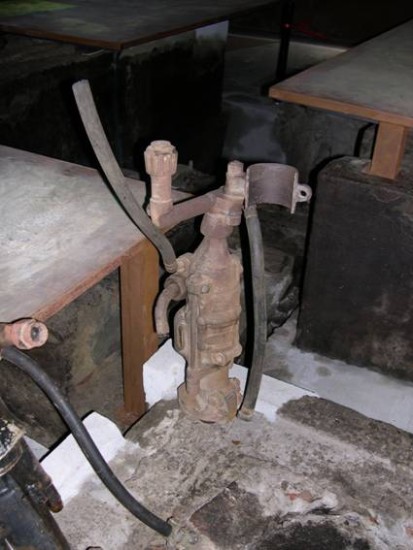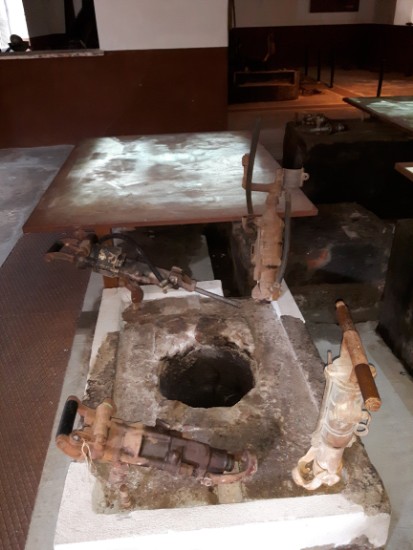PERFORATRICI - MUSEI DELLE MINIERE - ARBUS
Menu principale:
- HOME - CEAS DI INGURTOSU
- COSA VISITARE
- MINIERA DI INGURTOSU
- CANTIERE DI POZZO GAL
- SALA COMPRESSORI
- PERFORATRICI
- SALA ARGANO
- IL CRIVELLO SARDO
- POZZO
- GABBIE
- VAGONE
- TRAMOGGE
- COMPRESSORE
- GALLERIA
- MOSTRA ENTOMOLOGICA
- MINIERA MONTEVECCHIO
- COLLEZIONE SANNA-CASTOLDI
- MUSEO DEI MINERALI
- MUSEO DEI DIORAMI
- POZZI MINERARI
- POZZO AMSICORA
- LAVERIE
- MINERALI
- CONTATTI
- NEWS
PERFORATRICE
Martello pneumatico, a rotazione e percussione per praticare i fori da mina. La perforazione del foro avviene tramite un' asta metallica (fioretto) la cui punta è dotata di un tagliente acciaio al tungsteno. Tutto il sistema è sostenuto da un dispositivo chiamato "servo-sostegno" costituito da un pistone as aria compressa che imprime una forza assiale al fioretto facendolo avanzare.
La perforazione meccanica permette una rapidità di lavoro assai maggiore del lavoro a mano, e ciò in molti casi si traduce in un diretto vantaggio economico, perchè permette di velocizzare il lavoro. Le perforazioni meccaniche si possono distinguere in perforatrici a rotazione e a percussione, a secco o ad aria compressa e ad acqua. Per quanto riguarda le perforatrici ad aria compressa (BBR), l'aria funziona nei cilindri delle perforatrici come fosse vapore, ma senza però dare disturbo nei lavori, anzi concorre a ventilare l'ambiente e a raffreddarlo, poiché l'aria compressa assorbe nell'espansione una ragguardevole quantità di calore. Le perforatrici ad aria furono quindi ovunque impiegate con successo. All'inizio del '900 l’estensione della perforazione ad aria compressa (BBR) fu molto rapida e permise un consistente incremento delle produzioni. Dopo la seconda guerra mondiale venne estesa la perforazione ad umido (T21), le perforatrici funzionavano ad aria compressa e ad acqua.
BOHRER
Drucklufthammer mit Rotation und Schlag zum Bohren von Minenlöchern. Das Loch wird mit einem Metallstab (Folie) gebohrt, dessen Spitze mit einer Schneidkante aus Wolframstahl ausgestattet ist. Das gesamte System wird von einer Vorrichtung namens „Servounterstützung“ unterstützt, die aus einem Druckluftkolben besteht, der eine axiale Kraft auf die Folie ausübt, die sie vorwärts bewegt.
Das maschinelle Bohren ermöglicht eine viel höhere Arbeitsgeschwindigkeit als die manuelle Arbeit, und dies führt in vielen Fällen zu einem direkten wirtschaftlichen Vorteil, da es eine Beschleunigung der Arbeit ermöglicht. Das mechanische Bohren kann in Rotations- und Schlagbohrmaschinen, Trocken- oder Druckluft- und Wasserbohrmaschinen unterteilt werden. Bei Druckluftbohrgeräten (BBR) wirkt die Luft in den Zylindern der Bohrgeräte wie Dampf, ohne jedoch die Arbeit zu stören, sondern trägt im Gegenteil zur Belüftung und Kühlung der Umgebung bei Die komprimierte Luft nimmt bei der Ausdehnung eine beträchtliche Wärmemenge auf. Druckluftbohrer wurden daher überall mit Erfolg eingesetzt. Zu Beginn des 20. Jahrhunderts erfolgte die Ausweitung des Druckluftbohrens (BBR) sehr schnell und ermöglichte eine erhebliche Produktionssteigerung. Nach dem Zweiten Weltkrieg wurde das Nassbohren ausgeweitet (T21), die Bohrgeräte arbeiteten mit Druckluft und Wasser
DRILLER
Pneumatic hammer, with rotation and percussion for drilling mine holes. The hole is drilled using a metal rod (foil) whose tip is equipped with a tungsten steel cutting edge. The whole system is supported by a device called "servo-support" consisting of a compressed air piston which imparts an axial force to the foil making it advance.
Mechanical drilling allows a much greater speed of work than manual work, and this in many cases translates into a direct economic advantage, because it allows to speed up the work. Mechanical drilling can be divided into rotary and percussion, dry or compressed air and water drilling machines. As far as compressed air drilling rigs (BBR) are concerned, the air works in the cylinders of the drilling rigs as if it were steam, but without however disturbing the work, on the contrary it contributes to ventilating the environment and cooling it, since the compressed air absorbs expansion a considerable amount of heat. Air drills were therefore used with success everywhere. At the beginning of the 1900s the extension of compressed air drilling (BBR) was very rapid and allowed a substantial increase in production. After the Second World War wet drilling (T21) was extended, the drills operated on compressed air and water.



HOME - CEAS DI INGURTOSU | COSA VISITARE | MINIERA DI INGURTOSU | CANTIERE DI POZZO GAL | SALA COMPRESSORI | PERFORATRICI | SALA ARGANO | IL CRIVELLO SARDO | POZZO | GABBIE | VAGONE | TRAMOGGE | COMPRESSORE | GALLERIA | MOSTRA ENTOMOLOGICA | MINIERA MONTEVECCHIO | COLLEZIONE SANNA-CASTOLDI | MUSEO DEI MINERALI | MUSEO DEI DIORAMI | POZZI MINERARI | POZZO AMSICORA | LAVERIE | MINERALI | CONTATTI | NEWS | Mappa generale del sito